My Radish Experiment – Part 1
A little over a month ago I decided to experiment with the Radish Fiction reading app, using a 3-book romance series that I wrote years ago as the guinea pig. The reading app model is a fairly new one, but with even Amazon getting into the game with Vella, it seems like the model may be sticking around for a while. Radish looks to be one of the biggest players, so I thought it was worth walking through to see what the process was like from an author perspective. I’ve been providing regular updates to the authors on my weekly newsletter, but now that I’ve started to get some results, a bigger more detailed analysis is warranted. I’m calling this Part 1, though, as not all of the data is in yet so I’m sure there will be at least one more future update.
What is Radish and how does it work?
Fiction Apps have been around for a while, but it seems like authors have only recently begun to start looking at them more seriously as an alternative revenue source.
In general, the idea is to sell books in chunks via an app, with readers paying on more of a chapter-by-chapter basis, rather than for the entire book all at once. It’s the television series model applied to books, where each new “episode” is released on a set schedule (daily, weekly, etc) in an attempt at hooking readers into having to return to the platform in order to catch each new episode’s release. Depending on the payment model you choose, they can view those new episodes for free by waiting or pay to unlock them sooner, although you can alter those details in many different ways – not only in terms of how long they have to wait or how many episodes they can view for free, but by making the whole thing free or the whole thing pay only.
Radish Terminology
Because of this model, Radish uses different terminology than authors are used to, so it’s worth quickly running through a few of the key terms to explain what they roughly equate to in the book world and how they differ.
Radish Term: Story
Book Equivalent: Book
A Radish story can actually be a single book or a series (with individual books being seasons within that story). Alternatively, you could just have a separate story for each book in a series, although from what I can tell it’s hard to tie them together as a series that way. The main factor to consider is that whichever pricing model you choose applies at the story level, so if you want to use different pricing models per book in a series, you need to set them up as separate stories.
Radish Term: Episode
Book Equivalent: Chapter
An episode is roughly a chapter, although it doesn’t have to be. Ideally you would break each chapter at an exciting point or cliffhanger, if possible, which helps entice readers to come back for the next episode. Also, because of the episodic nature and that readers may be paying per episode, it’s best to try and aim for episodes to be roughly similar in length. For those reasons, it sometimes makes sense to make an episode span more than one chapter, or even break a lengthy chapter into multiple episodes.
Radish Term: Season
Book Equivalent: Books in a series
A story can span multiple seasons, which to me roughly equates to different books in a series. However, because of the pricing model applying at the story level, it doesn’t always make sense to use the season model for a series. Having seasons is optional, so if you just had a single book, you wouldn’t use them on your story at all.
Radish Term: View
Book Equivalent: Episode reads
Once your book is live you’ll start seeing “Views” on your dashboard, which is essentially the number of times an episode has been downloaded by a reader.
Payment
In terms of payment, the Radish model uses coins, with readers buying them from Radish and then spending them to unlock the next episode of the book (if it’s available/published). The price to unlock an episode is about 3 coins.
If you’re familiar with Amazon’s Kindle Unlimited program, you may notice a few similarities here. While KU readers pay one price that allows them to borrow unlimited books that are enrolled in the program, authors only get paid based on the number of pages that actually get read. That means that even though your entire book is sent to a KU borrower, if they only read the first 10 pages of your book, you only get paid for those 10 pages.
With Radish, readers aren’t getting your full book at once, but they are paying per episode (depending on your model) which means that like KU, you may end up only getting paid for part of a book.
Another similarity comes from a very recently introduced change to the Radish payout model, where they went from a fixed coin value (of roughly 4 cents) to one that fluctuates month by month, much like Amazon’s page read value. Essentially they are calculating coin payout price by dividing overall coin income by number of coins spent. If all customers paid a fixed price per coin, the payout amount wouldn’t change, but because Radish now wants to account for all of the discounts and free coin giveaways that they use for promotion, the overall coin pool is being increased even as the overall coin income becomes decreased (or at best, stays the same), which leads to a much lower coin value under this new model (in May, authors were paid 2.5 cents per coin). In defense of this, Radish claims that it evens out because more coins are available to be spent on episodes, but all of the authors I’ve spoken to have reported a drastic decrease in their Radish earnings under this new model.
Depending on size of book and number of chapters/episodes, on the surface it actually may seem like a full book read payout is similar between the two models. For instance, if you had a 20 chapter, 300 page book that was read cover to cover under KU, you’d earn about $1.35 (assuming a page read rate of .0045). For that same book on Radish, a full cover to cover read would earn you $1.50 (20 episodes, 3 coins per episode at .025 each).
Unfortunately, though, under most of the Radish pricing models, I’d argue (and will explain why later) that it’s virtually impossible that you’d ever get paid the full amount for your book even when it is read from front to back, because some, if not all, of your chapters will be read for free. Only the Premium pricing model forces readers to pay for every episode, and that pricing model is not a popular choice among authors.
Radish Pricing Models
Speaking of which, there are a few different pricing models to choose from.
Premium – Readers must pay 3 coins for each episode. While this sounds great at first, most readers on Radish are used to getting at least some chapters for free and Radish doesn’t typically recommend using this unless you already have your own following of fans. None of the authors I spoke to were using this model.
Freemium – Readers have to pay 3 coins for each episode at first, but soon after publication each episode becomes completely free.
Free – This option means your book is completely free to everyone immediately, and is the only option you can use if your book is published free somewhere other than Radish, although it’s also used by new authors trying to build up a following.
Wait-to-Unlock – According to Radish, this model is the most popular and earns more coins than both Premium or Freemium, and from the authors I’ve spoken to, it is the common choice. It’s sort of a blend between Premium and Freemium, allowing the author to specify a number of initial free chapters (i.e. the hook), a number of pay only chapters (always the final chapters currently published), and the ones in between being pay immediately or wait a specified time to unlock. I suppose because of the different variables, this option is only available by emailing Radish support with your desired settings and asking them to enable it on the backend.
For example, let’s say you have a story that is 30 episodes in length and you have set them to publish daily under the Wait-to-Unlock model. And let’s say you have a really good first few episodes that have a really strong cliffhanger type hook at the end of episode 4, and your book climax starts around episode 25. In that case, you might decide to make the first 4 episodes free and have 6 episodes that are pay only. The rest are set as Wait-to-Unlock with whatever time increment you choose (Radish recommends an hour, most authors I spoke to choose a longer number).
I found it a bit confusing at first, especially the idea of the rolling final 6 pay only chapters. Essentially, this just means that as a book is publishing, it’s always the final 6 episodes that are published that are pay only, which changes day-by-day until the entire book is published.
So to go through the details using the example numbers outlined above, for the first 4 days, each episode publishes and is free because you chose the first 4 episodes to be always free. On the fifth day when episode 5 publishes, anyone that wants to read it MUST pay 3 coins. Same for the next 5 days meaning that by day 10 when you have 10 episodes published, the first 4 are free and the next 6 are all pay only. But on day 11, episode 5 now becomes Wait-to-Unlock, and episodes 6-11 are now pay only. On day 12, episodes 5 and 6 are Wait-to-Unlock, and episodes 7-12 are pay only. And so on until the entire book is published, at which point episodes 1-4 are free, episodes 5-24 are Wait-to-Unlock, and episodes 25-30 are pay only.
Radish Experiment Details
For this experiment, I ended up posting a 3 book romance series (each stand-alone but interconnected) that I originally wrote and published years ago but haven’t touched since. Like most of my old books, they’re still available for sale on Amazon and other sites, but as I haven’t published anything new on that pen name in a couple years or done any sort of marketing or promotion, they’re mainly languishing.
However, I specifically chose this series because it was a very strong seller back when it was originally released (earning in the low 6 figures on Amazon within the first year of release, according to Book Report), which was important because I wanted to give this experiment every advantage to succeed. If I had uploaded a dud, or even something new, it would be harder to draw many conclusions regarding how well Radish moves books. By using something that sold well, we at least know that any sales deficiencies are likely due to other reasons beyond book quality or overall desirability. For that reason I also used the original blurbs, titles and “general” cover design.
I say “general” cover design, because another Radish quirk is that you can’t have any writing on your cover. Radish overlays your title and penname onto the cover image as part of their overall app design, and because I didn’t have my original cover design files (or even remember who designed them in the first place), I had to have Nate remake them. Luckily he was able to find the same original cover model images, so what we ended up with was very close to the original.
Story Setup Choices
I chose to upload the series as a single story, but each book as a different season under the Wait-to-Unlock model. When I originally did this, though, my understanding of how Radish worked was more limited and I didn’t realize two key points:
- As with Amazon, if a book is free elsewhere it must be listed free on Radish
- A story can only have one pricing model regardless of seasons (i.e. you can’t have a different pricing model per season) and the settings apply to the story as a whole (not individually against each season)
The first point was only an issue because of the series I chose. Since I no longer advertise or promote these, I’ve set book 1 as permafree everywhere to help drive sales to books 2 and 3. This meant I had to also make book 1 free on Radish, but because of the second point, I couldn’t simply use the free pricing plan for season 1 and Wait-to-Unlock for the others. Worse, the Wait-to-Unlock settings apply to the entire story across seasons/books. This meant that in order to make season 1 free, I had to make AT LEAST the first 27 episodes free (the number of episodes in book 1).
I could have made more than that free – for example if I wanted the first 5 episodes of book 2 to be free, I could have set the first 32 episodes to be free – but that still would have meant no free episodes for book 3. Therefore I just left the free episodes at 27, used 6 chapters as my rolling pay only number, and set the wait time for the rest to 2 hours.
Since I had to make book 1 free, I published the entire season immediately, but set the remaining episodes (for seasons 2 and 3) to publish at a rate of 1 per day.
Note: At the time of me putting this article together, the entire season/book 2 was published but none of season/book 3, thus the following numbers and analysis are based on that.
Data Breakdown
Radish does provide some data and insight, but it’s fairly limited and thus I’ve had to make some estimations, guesses and assumptions to derive something meaningful out of it, but I’ll explain. First, here’s a screenshot of the spreadsheet I’m using to track and analyze my raw data and results.
At the top is the raw data – the number of episodes in total and published so far per book/season, how many episode views (reads) each has had, and how many coins were earned. Remember that as book 1 is free and book 3 is not yet published, only book 2 has earned coins so far. The yellow(ish) cells are the ones I manually edit from my Radish dashboard whenever I want to update this spreadsheet.
Assumptions and Numbers
Everything below the raw data section is calculated, and this is where I try to make some sense of the data, and also where I have to make some assumptions. The big assumption is the idea that each reader reads all chapters, which I KNOW is not correct, but given that I can’t get a breakdown, I think it’s the best way to simplify things. Besides, for most purposes it doesn’t really matter whether it’s 1 person reading the book in total or 2 people reading half the book each. It’s also the same assumption many KU authors use to try and guesstimate the number of borrows a book has (total page reads divided by number of pages in the book).
Book Readers
So that means that where you see 413 Book 1 Readers, that calculation is simply number of total episode views of book 1 divided by the number of chapters published for book 1. Similar with the Book 2 Readers.
Read Through Bk 1 – 2
While the books are written to be stand-alone, I think it’s a reasonable assumption to assume most people are starting on book 1 and then reading book 2 (especially since book 1 is free). That means that if we divide book 2 readers by book 1 readers we get the % of people that continued on to read book 2 after reading book 1. Obviously you want a really high number here, as it means your series is really sticky, keeping people hooked from book to book. If I had a 59% read through on Amazon I’d be ecstatic, as that’s very high. On Radish, it’s not as impressive as it seems, but I’ll explain why shortly.
Book 2 Episodes Purchased
When someone buys an episode on Radish, it costs roughly 3 coins, thus to find out how many episodes were purchased I simply divided the coins earned for that book by 3.
Book 2 Sale/Giveaway Equivalents
The Radish model is trickier than KU when it comes to figuring out how many people are really paying for the book. With KU, someone either borrows the book or they don’t, and then from those borrows they read all or part of the book. Hopefully most read all of it, but even from those that read part of it you still get paid for whatever they DO read.
With Radish’s Wait-to-Unlock model, it’s possible that a reader can read most (if not all) of your books for free if they’re patient enough (with the exception of the final pay only chapters), and it’s very likely that NO ONE is paying for the full book. That’s because with each chapter unlocking after a certain amount of time (2 hours in my case), unless they’re reading it in a single sitting (and paying to unlock each episode immediately), just putting the book down to do something else or when you go to sleep means the next chapter will be unlocked for free upon return.
For that reason, trying to separate the readers into payers vs freeloaders on the whole is pretty much impossible as the pool of readers is likely made up of a whole bunch of people that just paid for a few chapters. So instead, I decided to just break it down by sale or giveaway “equivalents”. That is, chapters paid for (541) divided by number of chapters (27) gives us the equivalent of 20 full paid book reads.
If we consider 243 as the total full copies of book 2 read, that means the remaining 223 copies were read for free. As a percentage, that means only about 8% of books were paid for, and almost 92% were given away.
Now you see why I’m not so impressed with the 59% read-through number. I don’t have any hard data to back it up, but I’m willing to bet that read-through on a series is much higher when the books are free.
Analysis
As you can see in the green box, when calculated at the rate of last month’s coin value, so far the series has earned $41.55. A far cry from what it earned on Amazon when it was first released, but despite my attempts at keeping things as similar as possible, it’s actually very hard to draw fair comparisons here.
For one, I’m doing no advertising on these books and I wouldn’t even know how to advertise them if I wanted to. I honestly have no idea how the discoverability really works with Radish beyond people just searching through lists and preset keywords via the app. When I originally released this series years ago, I spent lots of money on advertising.
Another factor is that so far I’m only earning on book 2, and the final chapter of book 2 was only published yesterday. Readers still need time to get caught up. And then once book 3 is in the mix and the whole series is published, maybe that’ll lead to more readers coming on board (not having to wait a day between episodes for those that like to binge).
In fact, a more accurate comparison might be to compare what the books are earning on Amazon right now, when they haven’t been advertised in years and have very little organic discoverability.
From that perspective, things get more interesting.
In the last 30 days, the entire series has only earned $33.82 on Amazon, which means Radish has actually earned 23% more in the same time frame.
But we can narrow things down even further, because only book 2 is actually for sale on Radish (book 1 is free and book 3 is not yet published), which means I should be comparing the Radish results ONLY against the book 2 Amazon results.
As it turns out, book 2 has only earned $15.83 in the last month on Amazon, which means Radish is actually earning me 162% more than Amazon!
Does that mean we should all dump Amazon and run over to Radish?
Of course not… keep in mind that this is a very small sample size and still very small numbers. I have no info on what sort of long tail any sales will have, if the numbers will increase if I added more books to the pen name, how book 3 will do, etc.
But aside from that, there’s one other important factor to take into consideration – the importance of which may vary between author to author.
In order to earn these 20 sales, I had to give away 223 copies of book 2.
It’s one thing to use a book 1 permafree strategy to drive sales of later books in a series (as I’m doing on both sites – and for those curious, Amazon gave away 316 free copies of book 1 vs Radish’s 413 in the last month), but it’s quite another to be giving away hundreds of copies of a book that you really want to get paid for (book 2), just so that you can get a few sales out of it as well.
I think for many authors, that issue alone may be a deal breaker.
That’s it for now, but once I have the numbers in for book 3 I’ll be back with part 2 of my Radish experiment. In the meantime, f you have any questions feel free to email me or post them in the comments below. And that includes if you think any of my calculations are off, or if you disagree with any of my analysis!


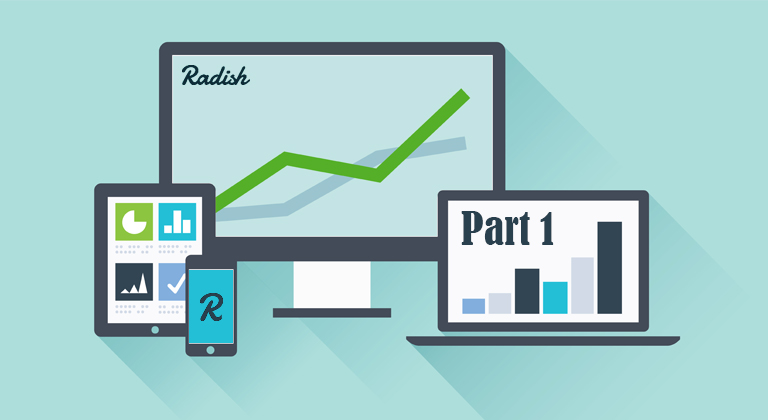

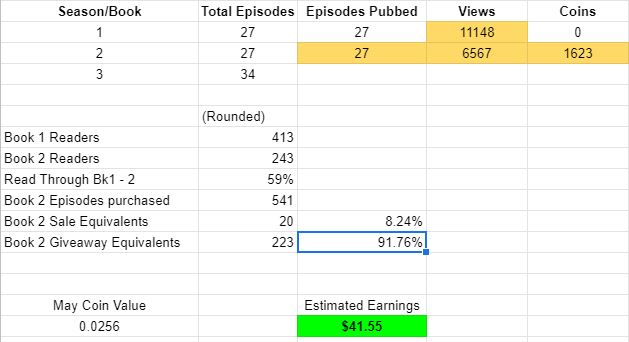

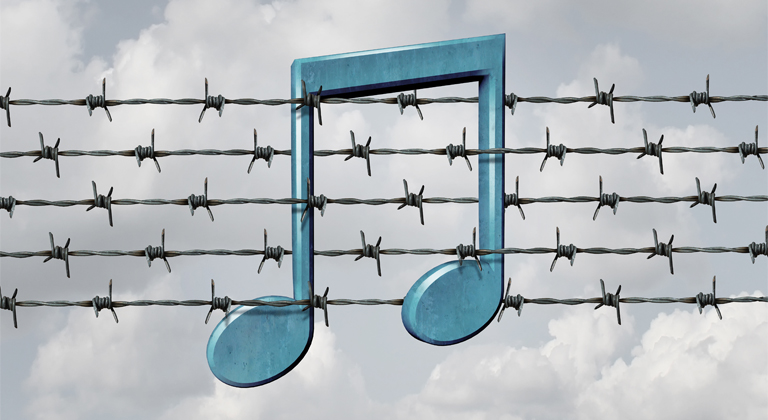

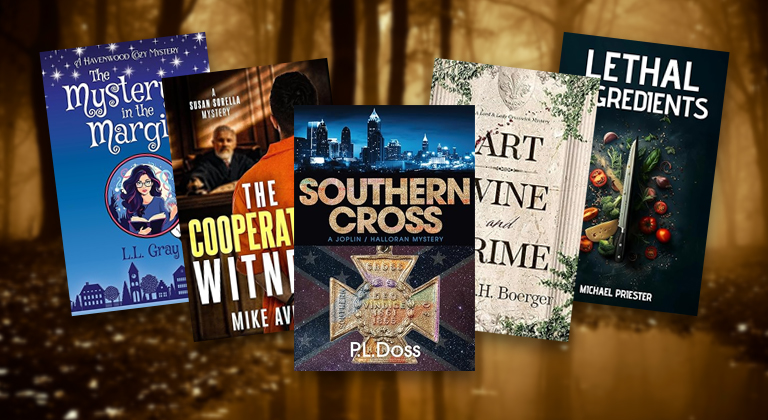
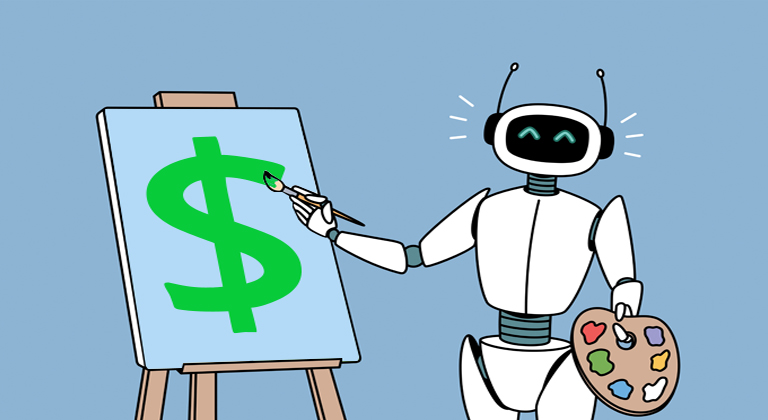

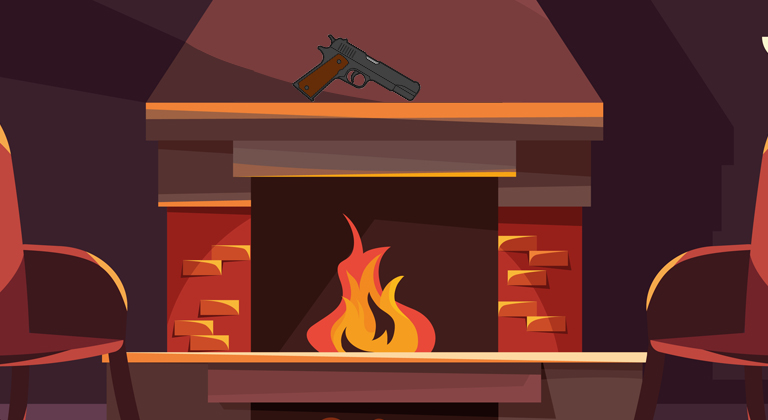

Thank you so much for sharing your experience. I’m just about to publish on Radish for the first time and your information clarified a lot of things for me. The one thing I don’t get, though, is the “Last Holdback Episode’ box. Can you shed any light on that? Thanks again for taking the time to share.
Hi Sashae,
I don’t believe that option was there when I ran this experiment and I haven’t really used the platform much since, other than to occasionally check my earnings. However, from what I can tell, this option is basically used with the wait to unlock model, and it specifies the number of episodes that readers can read for free before paying. So if it was set to 6, then the six most recent episodes would only be available for pay, but previous ones would all be free.
Thanks for posting this article, it’s well put together and very informative!
This was a WONDERFUL breakdown of Raddish! Thank you so much. I HATE the app, and have been reading the same book for well over a year and will probably be reading it until the day I die, unless the author dies first. You see, there is no end. After much backlash, they finally notified us readers that this book is like a TV show and the writers (yes, no longer a single author as it was in the beginning) are constantly writing new episodes daily. I’m on, and this is no joke, Season 115 and Episode 2,781.
This book is more like the soap operas our grandma’s or stay at home mom’s watched back in the day. Some TV soaps (think Days of Our Lives or All My Children) have been around for 30+ years. There isn’t a finale planned, there isn’t a climax and hero or heroine, there aren’t normal parts that make up a normal book, because it’s not a book! These writers read the comments the readers leave after each chapter (genius) and just keep on writing based on what’s liked and what’s not. The book is called “The Billionaire’s Surrogate” and that makes me laugh because that situation seems like a million years ago. They’re now madly in love, have two kids, have been in jail, have been reality stars, have been kidnapped, have been accused of murder, have written famous cookbooks, have been the stars of a reality cooking show, have been close to death after skydiving, have been in a plane crash, have lived and survived on a deserted island, have tried to get married ten times, etc., etc., etc. Think of the greatest things that could happen in life and think of the worst things that could happen in life…these two characters have experienced them ALL and will continue to find themselves in ridiculous and outlandish predicaments until the author dies or the team of writers quit or Raddish shuts down lol.
Sorry for the rant, I’ve just had it. But…I don’f pay a penny for these episodes (maybe 2-3 paragraphs long), but SO many readers of this book do. They’re addicted to the story and to finding out what happens next. I’ve seen women in the comments complain about spending $100 in a weekend, and some claim they’ve spent THOUSANDS on this book because they buy like 3 coins at a time. I haven’t done the math, but with almost 3,000 episodes. I’m sure they’ve definitely spent hundreds.
Because of this never ending “book”, they have since put out disclaimers letting people know there is no current end in sight and that there are now a team of writers much like a soap opera (they actually say that) that co tongue to write and publish daily episodes. If this would have been advertised this way in the beginning, I would have never downloaded the app to read the book they were advertising when I first saw it come across my Facebook feed. This is the book they were advertising, obviously, since it’s the only one I’ve read, I mean partially read.
I just think this is a scam and for this reason, I’ll never read another book on this app because I don’t have another 30 years to spare!
Interesting. I just started on Radish this month. I’ve noticed that each of my episodes are earning either three coins or two coins. Hard to imagine why two coins would be used. I just assumed that one coin = one reader. Maybe not? I would be a bit shocked to think that only one person has been reading all my episodes so far… And by the way, I’ve used Premium so far, though this may change. Am hoping July will bring more readers, as I finish up the episodes.
(Maybe I was confused by the publishing form, but I thought I had to do a Season 1 even though it’s a standalone book. I suppose I could contact the strangely unhelpful customer service about that. They seem extremely overextended right now!)
Episodes are supposed to cost 3 coins but from what I understand, in cases where they give out promotional coins, those coins don’t register because they were free so basically someone still buys your episode for 3 coins but they may have used 1 of their “free” coins and 2 regular coins, which is why you are only paid for 2.
In my opinion, giving out promotional coins is Radish’s choice and cost of doing business, and that cost shouldn’t be passed along to the authors at all. I don’t agree with that practice as I think it’s completely unfair to authors. Radish should eat that cost and write it off as a marketing expense.
As for seasons – when you create the book I believe on the first page you have to choose whether to do seasons or not. If it’s a stand-alone book you don’t need to do seasons. Doesn’t hurt anything if you do, I don’t think, other than that it may cause readers to expect that there will be a season 2.
I’m about to start the Radish journey. It’s completely experimental. Just want to say how thankful I am you did this blog post, because I find it to be confusing as f*ck. Your post helps a ton.